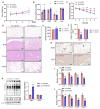The SIRT5-Mediated Upregulation of C/EBPβ Promotes White Adipose Tissue Browning by Enhancing UCP1 Signaling
- PMID: 39408844
- PMCID: PMC11476608
- DOI: 10.3390/ijms251910514
The SIRT5-Mediated Upregulation of C/EBPβ Promotes White Adipose Tissue Browning by Enhancing UCP1 Signaling
Abstract
Sirtuin 5 (SIRT5) plays an important role in the maintenance of lipid metabolism and in white adipose tissue browning. In this study, we established a mouse model for diet-induced obesity and the browning of white fat; combined with gene expression intervention, transcriptome sequencing, and cell molecular biology methods, the regulation and molecular mechanisms of SIRT5 on fat deposition and beige fat formation were studied. The results showed that the loss of SIRT5 in obese mice exacerbated white adipose tissue deposition and metabolic inflexibility. Furthermore, the deletion of SIRT5 in a white-fat-browning mouse increased the succinylation of uncoupling protein 1 (UCP1), resulting in a loss of the beiging capacity of the subcutaneous white adipose tissue and impaired cold tolerance. Mechanistically, the inhibition of SIRT5 results in impaired CCAAT/enhancer binding protein beta (C/EBPβ) expression in brown adipocytes, which in turn reduces the UCP1 transcriptional pathway. Thus, the transcription of UCP1 mediated by the SIRT5-C/EBPβ axis is critical in regulating energy balance and obesity-related metabolism.
Keywords: SIRT5; UCP1; fat synthesis; protein succinylation; white adipose tissue browning.
Conflict of interest statement
The authors declare no conflict of interest.
Figures






Similar articles
-
Fto-Deficiency Affects the Gene and MicroRNA Expression Involved in Brown Adipogenesis and Browning of White Adipose Tissue in Mice.Int J Mol Sci. 2016 Nov 7;17(11):1851. doi: 10.3390/ijms17111851. Int J Mol Sci. 2016. PMID: 27827997 Free PMC article.
-
Lipopolysaccharide-binding protein is a negative regulator of adipose tissue browning in mice and humans.Diabetologia. 2016 Oct;59(10):2208-18. doi: 10.1007/s00125-016-4028-y. Epub 2016 Jun 25. Diabetologia. 2016. PMID: 27344313
-
SIRT5 Regulates Brown Adipocyte Differentiation and Browning of Subcutaneous White Adipose Tissue.Diabetes. 2019 Jul;68(7):1449-1461. doi: 10.2337/db18-1103. Epub 2019 Apr 22. Diabetes. 2019. PMID: 31010955
-
Understanding the Biology of Thermogenic Fat: Is Browning A New Approach to the Treatment of Obesity?Arch Med Res. 2017 Jul;48(5):401-413. doi: 10.1016/j.arcmed.2017.10.002. Arch Med Res. 2017. PMID: 29102386 Review.
-
Transcriptional regulation of the uncoupling protein-1 gene.Biochimie. 2017 Mar;134:86-92. doi: 10.1016/j.biochi.2016.09.017. Epub 2016 Oct 5. Biochimie. 2017. PMID: 27693079 Review.
Cited by
-
Brown and Beige Adipose Tissue: One or Different Targets for Treatment of Obesity and Obesity-Related Metabolic Disorders?Int J Mol Sci. 2024 Dec 11;25(24):13295. doi: 10.3390/ijms252413295. Int J Mol Sci. 2024. PMID: 39769065 Free PMC article. Review.
-
Subcutaneous adipose tissue [18F]FDG uptake and CT-derived body composition variables for predicting survival outcomes in patients with locally advanced gastric cancer.Eur J Nucl Med Mol Imaging. 2025 Apr 24. doi: 10.1007/s00259-025-07296-x. Online ahead of print. Eur J Nucl Med Mol Imaging. 2025. PMID: 40272500
References
MeSH terms
Substances
Grants and funding
LinkOut - more resources
Full Text Sources
Medical
Research Materials

